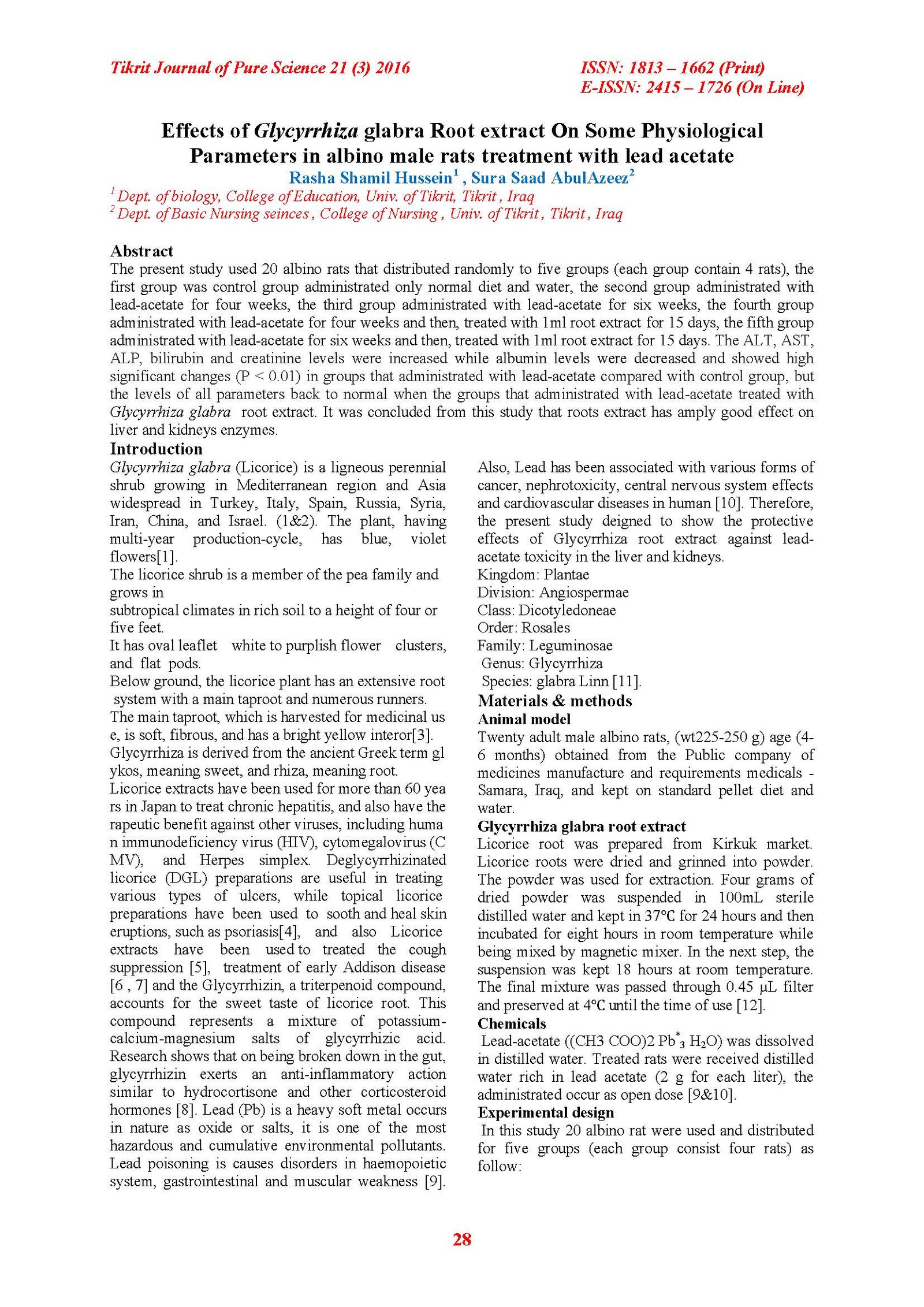Effects of Glycyrrhiza glabra Root extract On Some Physiological Parameters in albino male rats treatment with lead acetate
Main Article Content
Abstract
The present study used 20 albino rats that distributed randomly to five groups (each group contain 4 rats), the first group was control group administrated only normal diet and water, the second group administrated with lead-acetate for four weeks, the third group administrated with lead-acetate for six weeks, the fourth group administrated with lead-acetate for four weeks and then, treated with 1ml root extract for 15 days, the fifth group administrated with lead-acetate for six weeks and then, treated with 1ml root extract for 15 days. The ALT, AST, ALP, bilirubin and creatinine levels were increased while albumin levels were decreased and showed high significant changes (P < 0.01) in groups that administrated with lead-acetate compared with control group, but the levels of all parameters back to normal when the groups that administrated with lead-acetate treated with Glycyrrhiza glabra root extract. It was concluded from this study that roots extract has amply good effect on liver and kidneys enzymes.
Article Details

This work is licensed under a Creative Commons Attribution 4.0 International License.
Tikrit Journal of Pure Science is licensed under the Creative Commons Attribution 4.0 International License, which allows users to copy, create extracts, abstracts, and new works from the article, alter and revise the article, and make commercial use of the article (including reuse and/or resale of the article by commercial entities), provided the user gives appropriate credit (with a link to the formal publication through the relevant DOI), provides a link to the license, indicates if changes were made, and the licensor is not represented as endorsing the use made of the work. The authors hold the copyright for their published work on the Tikrit J. Pure Sci. website, while Tikrit J. Pure Sci. is responsible for appreciate citation of their work, which is released under CC-BY-4.0, enabling the unrestricted use, distribution, and reproduction of an article in any medium, provided that the original work is properly cited.
References
1. Asada, Y., Li, W., & Yoshikawa, T. (2000). Biosynthesis of the dimethylallyl moiety of glabrol in Glycyrrhiza glabra hairy root cultures via a non-mevalonate pathway. Phytochemistry, 55, 323–326.
2. Casulli, F., Ippolito, A. (1995). Observations on liquorice rust (Uromycesglycyrrhizae) in southern Italy. Informatore-Fitopatologico, 45, 27-30.
3. Olukoga A, Donaldson D. Historical perspectives on health. The history of liquorice: the plant, its extract, cultivation, and commercialisation and etymology. J R Soc Health 1998;118:300-304.
4. Lakshmi T. and Geetha R.V. (2011). Glycyrrhizaglabralinn commonly known as licorice: a therapeutic review. J. Pharm. Pharm. Sci. 3 (4):20-25.
5. Anderson DM, Smith WG. The antitussive activity of glycyrrhetinic acid and its derivatives. J. Pharm. Pharmacol. Jul 1961;13:396-404
6. 6 Cooper H, Bhattacharya B, Verma V, McCulloch AJ, Smellie WS, Heald AH. Liquorice and soy sauce, a life-saving concoction in a patient with Addison's disease. Ann ClinBiochem. Jul 2007;44(4):397-9.
7. Ross EJ. Liquorice and Addison's disease. Br Med J. Jun 20 1970;2(5711):733
8. Sharma, V. and R. C. Agrawal. (2013). Glycyrrhizaglabra- a plant for the future. J. Pharm. Med. Scien. 2(3): 15-20.
9. Hanan, A. A. and Riham, M. R. (2012). Effect of Lead Toxicity on Cytogenisity, Biochemical Constituents and Tissue Residue with Protective Role of Activated Charcoal and Casein in Male Rats. J. Bas. Appl. Scien., 6(7): 497-509.
10. Ibrahim, N. M., Esam A E., Hossam S. and Yasmin E. (2012). Effect of lead acetate toxicity on experimental male albino rat. J. Trop Biomed; 2(1): 41-46.
11. Damle, M. (2014).Glycyrrhizaglabra (Liquorice) - a potent medicinal herb. J. Herbal Med. 2(2): 132-136.
12. Haji Mahdipour H, Amanzadeh Y, Hasanlou T, Shekarchi M, Abedi Z, PiraliHamedani M. (2008). Investigating on the Quality of Wild Licorice Roots Collected from Different Regions of Iran. J Med Plants.7: 101-106.
13. Beth, D.; Robert, G. and Trapp. (2004). Basic and clinical biostatistics, 4th ed. Lange Medical Books/ McGraw-Hill Medical Publishing Division. New York. PP: 83-154.
14. Azoz, H. A. and Riham, M. R. (2012). Effect of lead toxicity on cytogenisity, biochemical constituents and tissue residue with protective role of activated charcoal and casein in male rats. J. Bas. App. Scien., 6(7): 497-509.
15. Haouas, Z., Sallem A., Zidi I., Hichri H., Mzali I. and Mehdi M. (2014). Hepatotoxic effects of lead acetate in rats: histopathological and cytotoxic studies. J CytolHistol, 5 (5): 256-262.
16. Saleem, M. M., Arieg A. W. M., Jazaer A. and Ghassan M. S. (2011). Biological study of the effect of licorice roots extract on serum lipid profile, liver enzymes and kidney function tests in albino mice. J. Biotech. 10(59):12702-12706.
17. Ashour, A.A., Maged M. Y., Nahed M. A. and Rokaya M. A. (2007). Blood, serum glucose and renal parameters in lead-loaded albino rats and treatment with some chelating agents and natural oils. Turk J Biol. 31 :25-34.
18. EL-Kenawy, S.S., A and El-Sahra, D. (2009). Protective effect of licorice on metiram fungicide induced liver injury in mice. 3 (2): 787-793.
19. Hamza, A. A. (2007). Curcuma longa, Glycyrrhizaglabra and Moringaoleifera Ameliorate Diclofenac-induced Hepatoxicity in Rats. J.Pharma. Toxicol. 2 (2): 80-88.
20. Amin, K. A. and Mohamed A. N. (2009). Effect of Carnitine and herbal mixture extract on obesity induced by high fat diet in rats. J. Diabetol.&Metab. Synd. 1 (17): 1-14.
